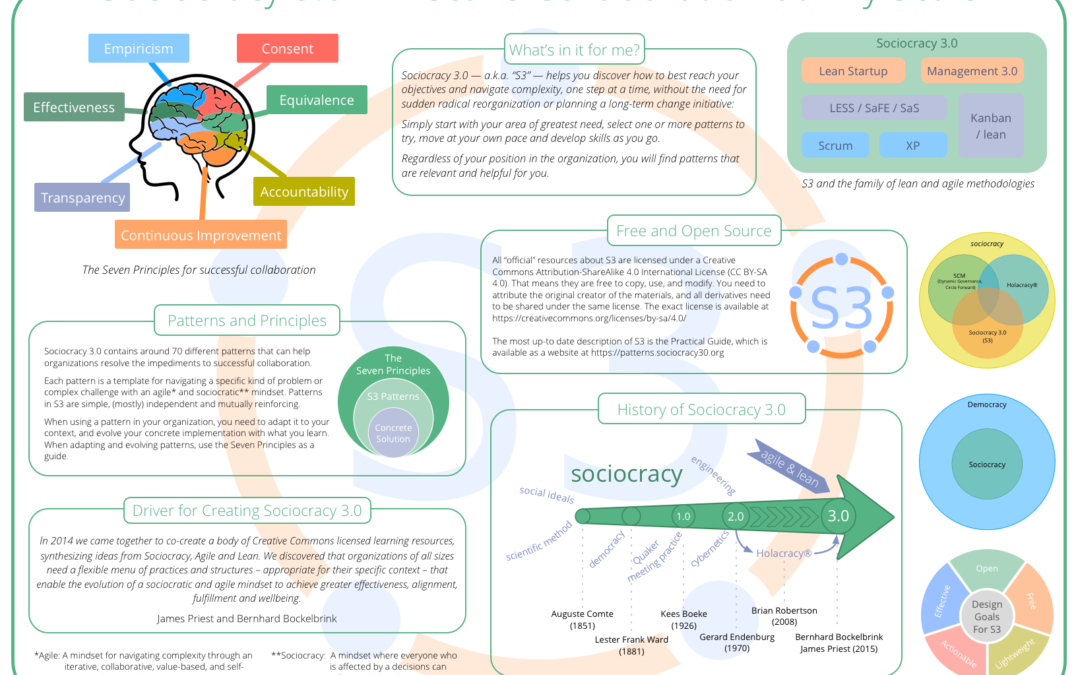
by Bernhard Bockelbrink | Nov 14, 2018 | download, s3dojo, Sociocracy 3.0, workshops/trainings
Here’s the second part of the posters I use in my S3 dojos to give people an overview over S3, the lens we view organizations through, and how people can use 70 patterns to respond to various challenges and opportunities in their organizations.
You can download the full set combined into one pdf that can be printed A1 or even A0. All the patterns in the pdf are clickable, so you can jump directly to the explanation of a pattern on the patterns website. The posters relate to the latest, as of now unreleased version of the practical guide, so some of the links (to new and renamed patterns) will only work after the next release.
Download Posters
Below you will find a brief description of each of the seven posters:
Sociocracy 3.0 – Effective Collaboration at any Scale
This poster introduces S3 and puts it into the context of various agile frameworks and methodologies.
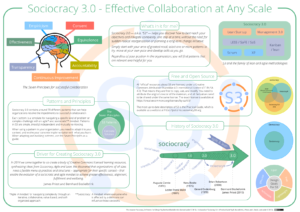
Making Sense of Organizations
This poster explains the relationships between drivers, domains, strategy and experiments, and how organizations identify and respond to drivers.

Responding to Complex Challenges
All the patterns related to making and evolving decisions and agreements in complex situations.
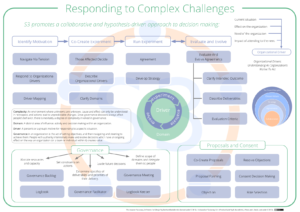
Building Structures for Collaboration
Those patterns hat are helpful for defining domains and for evolving organizational structure in support of effective agile collaboration.
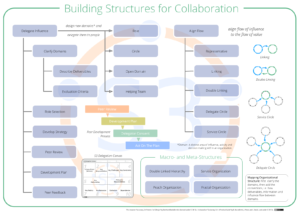
Operations – Organizing and Doing the Work
Patterns for self-organization, work process and effective meetings.

Enabling Engagement
While all patterns in S3 promote an agile and sociocratic mindset, the patterns in this poster are especially helpful in promoting a cultural shift in the organization.

Pattern Map
A (clickable) map of all patterns in S3.
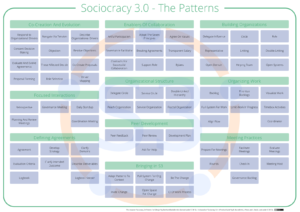
Download Posters

by Bernhard Bockelbrink | Nov 14, 2018 | download, s3dojo, Sociocracy 3.0
I have developed a set of posters for my S3 dojos, which I will make available under a Creative Commons license. The posters work well when printed in A1, for larger groups A0 might be a better choice.
The first poster I want to share is a poster about the Cynefin framework, which is very helpful at the beginning of a dojo to introduce participations to the concept of complexity, and to explain why they are typically using the wrong toolkit in their organizations when addressing the problems they are facing.
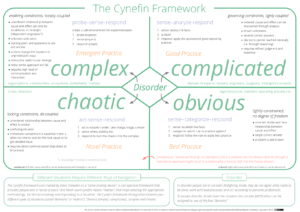
Download Cynefin poster (PDF)
Also there is a poster (in German) with all the patterns of the latest (so far unreleased) set of S3 patterns:

Download German Pattern Map poster (PDF)

by Bernhard Bockelbrink | Jan 30, 2017 | blog, download, news, slide deck, Sociocracy 3.0
James Priest, Lili Davidis and I spent a lot of time on a complete overhaul of the “All Patterns Explained” slide deck:
- patterns are grouped in a more meaningful way
- some new patterns and more descriptive names for existing patterns
- lots of updates, corrections, clarifications in the pattern descriptions
I also created some new illustrations for the slide deck, and updated a lot of existing ones. An update to the image repository will follow.
Download the slide deck as pdf, or as an archive with all slides as png.
Here’s an updated map of all the patterns and the categories: 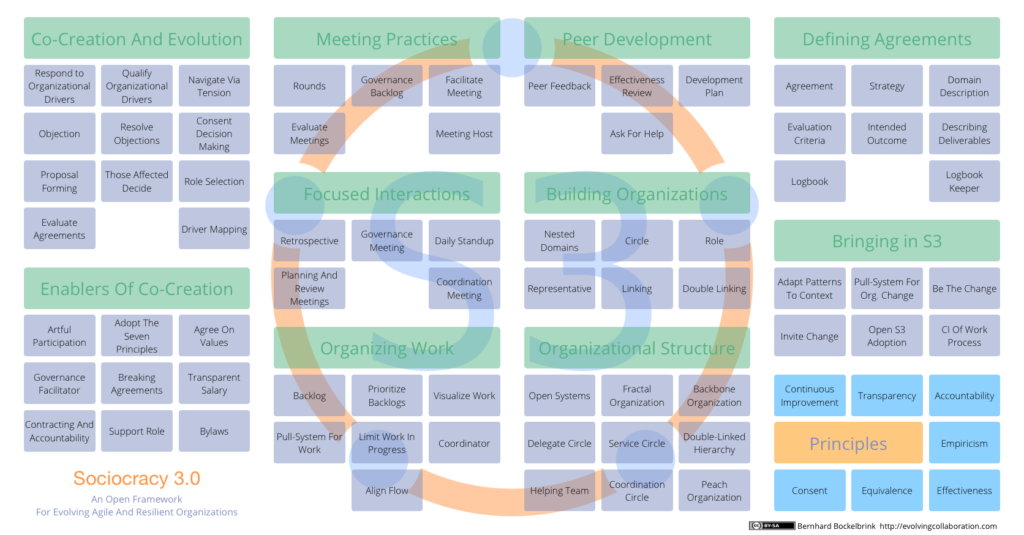
Enjoy!
by Bernhard Bockelbrink | Nov 23, 2016 | blog, eBooks, Sociocracy 3.0
I updated my my beta version of the Sociocracy 3.0 Handbook with new text and illustrations. now there’s a section on each of the 65 patterns. Download as PDF or EPUB, or take a look at the web version for mobile and desktop browsers here.

by Bernhard Bockelbrink | Nov 9, 2016 | blog, Sociocracy 3.0
Nun sind erstmals alle S3-Illustrationen in deutscher Übersetzung verfügbar, dazu gibt es kleinere Updates der englischen Version. Download über Dropbox oder Github
Die Illustrationen stehen unter einer Creative Commons Attribution-ShareAlike 4.0 International License.

by Bernhard Bockelbrink | Nov 4, 2016 | blog, Sociocracy 3.0
Sociocracy 3.0 (a.k.a. S3) is framework for agile organisations, i.e. set of tools for people to collaborate effectively on achieving their shared objectives.
S3 builds on the “Sociocratic Circle Organization Method” (SCM, a.k.a. Dynamic Governance in the US), agile software development and lean thinking, and draws inspiration from many other sources, e.g. the scientific method, Non-Violent Communication, the Core Protocols, Holacracy (another descendant of SCM), psychology, coaching and facilitation techniques.
S3 is a collection of many modular, but mutually reinforcing patterns to promote an agile (i.e. empirical and hypothesis-driven) approach for all aspects of organisations, including coordination of work, making and evolving agreements, effective meetings, governance, building organisations, developing people, organisational structure, organisational development, alignment, and last but not least rolling out and evolving S3 patterns.
A pattern is a template for addressing specific situations or challenges, which can be adapted to context as needed (there’s even a specific pattern for doing that). All of the currently more than 65 patterns in S3 are guided by seven principles: empiricism, consent, equivalence, effectiveness, accountability, continuous improvement and transparency.
A culture of collaboration
S3 is about building a culture of collaboration that is aligned to people’s natural drive for purpose, autonomy and mastery, but also caters to another equally important aspect that is often ignored in the discussion: everyone’s basic need for relationship and belonging. S3 brings people closer together by integrating diverse personalities and points of view into solutions for complex problems – building respect and trust in each other along the way.
We believe that an effective organisation is one that is easy to change. To that end, rather than implementing a rigid system of rules and policy, S3 aims to support people in building self-accountability and discipline required to make just as many agreements as are needed to be effective, and evolve them as necessary, periodically eliminating those agreements which are no longer helpful.
S3 and other agile methods
While other agile frameworks and methods usually focus on software development and project management, and mostly omit the questions of management and governance, organisational structure and organisational change, S3 brings agile thinking to all aspects of an organisation. It aims to solve some interesting challenges: how can we create a coherent agile culture throughout an organisation that is not limited by hierarchical structures or traditional ideas of management (which we know are incompatible to agile), and how can the people in agile organisations thrive, and at the same time discover and develop resources and skills to effectively contribute to a flourishing organisation.
S3 complements the Lean Startup Method, Scrum, eXtreme Programming, Software Kanban (both on a team level and Enterprise Kanban), SAFe, DAD, LeSS, OpenAgile and many other agile and lean methodologies, and it even provides a way to adapt and evolve those methodologies, when an organisation outgrows them.
How to start
The pattern-based approach of S3 allows for an agile (and more common-sense) approach to organisational change: we invite organisations to keep doing what they do well, and only change where there’s a need to evolve, by pulling in one or several of S3’s patterns to resolve actual challenges they’re facing. This way, an organisation can organically grow and adapt to change, at their own pace, which is a stark contrast to the revolutionary change that is is mandated by the all-or-nothing approach of e.g. Scrum or Holacracy, which poses a great risk to organisations, but makes a great business model for consultants.
Any organisation experimenting with agile is most likely already familiar with several of the patterns contained in S3, e.g. working from a prioritised backlog, or visualising work (usually on a Scrum board or a Kanban board) or holding retrospectives. What often helps agile teams take things to the next level are the S3 patterns around making and evolving agreements. Take for example Consent Decision Making, which can be used to evolve policy in teams implementing Kanban, or product or architecture decisions in a Scrum team. When scaling agile development, teams can use structural patterns like the Delegate Circle or the Service Circle to align their efforts across teams, e.g. around the functions of architecture or product decisions. This is often combined with the pattern for selecting people to roles to determine who best represents each teams in these circles.
There’s a brief overview over all patterns at the S3 site, and a beta version of the upcoming S3 handbook with more detailed descriptions for many patterns at https://evolvingcollaboration.com/sociocracy-3-0-patterns-ebook/
What’s next?
As more and more organisations experiment with S3, the framework will be expanded with more patterns, and existing patterns will be refined and updated with variants which proved to be useful. One example for this is the Driver Mapping pattern, which was discovered and evolved as organisations wanted to dive deeper into S3 and needed a way to identify a circle structure that would make their organisation more effective.
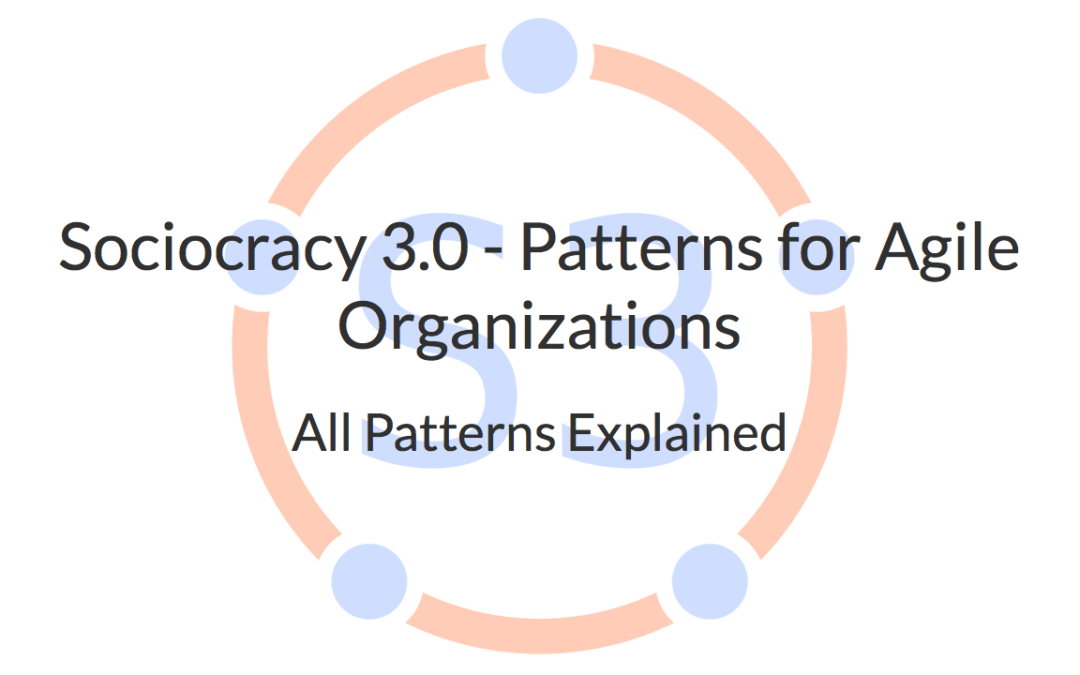
by Bernhard Bockelbrink | Aug 24, 2016 | blog, slide deck, sociocracy, Sociocracy 3.0
Updated 2017-01-30
download pdf download slides as png
A slide deck with descriptions for each of the patterns in Sociocracy 3.0 via the S3 webiste.
by Bernhard Bockelbrink | Jun 29, 2016 | blog, Sociocracy 3.0, workshops/trainings
Am Dienstag, 15. November 2016, 10:00 – 18:00 Uhr, in Berlin.
Anmeldung und weitere Details zur Konferenz: http://www.manage-agile.de/workshops/articles/gtws-4-agile-hr-mit-sociocracy-30.htm
Der wesentliche Erfolgsfaktor für agile Unternehmen (und solche, die es werden wollen), sind Mitarbeiter, die entweder bereits ein agiles Mindset besitzen und danach handeln, oder sich zumindest in diese Richtung entwickeln, im Idealfall selbstmotiviert und selbstorganisiert.
Einstellung und Entwicklung von Mitarbeitern wird jedoch in den meisten Unternehmen von HR-Abteilungen gesteuert, die selbst nicht agil arbeiten, die also – wenn überhaupt – nur theoretische Kenntnisse zum Thema Agilität besitzen. Und obwohl das Thema HR essentiell für agile Transitionen und für agile Unternehmen ist, beschäftigen sich die bekannten agilen Methoden und Vorgehensmodelle bisher nicht oder nur sehr oberflächlich damit.
Sociocracy 3.0 (a.k.a. S3) ist ein offenes agiles Framework für alle Organisationsbereiche, das bereits einige konkrete Patterns für selbstorganisierte HR-Prozesse mitbringt. Dadurch wird es möglich, sich mit S3 dem Thema “agile HR” auf ganz unterschiedliche Arten zu nähern: so können agile Teams ihre HR-Prozesse einfach selbstorganisiert gestalten, Teams und HR können ihre Zusammenarbeit verändern, und HR-Teams oder -Abteilungen können selbst nach agilen Prinzipien arbeiten.
Ziel des Workshops ist es, die Teilnehmer dabei zu unterstützen, konkrete Ideen zur Umsetzung “agiler HR” im eigenen Unternehmen zu entwickeln. (more…)

by Bernhard Bockelbrink | Jun 22, 2016 | blog, download, eBooks, Sociocracy 3.0
S3 has evolved significantly since this page was published, and we could not catch up with the handbook, so for now I removed the download linkls. The latest version can be found in the slide deck “All Patterns explained” or on http://sociocracy30.org.
Earlier this year I had compiled a handout for the participants of my workshops with descriptions of S3’s essential patterns. Over time, I updated the handout with the contents of the “All Patterns Explained” slide deck, several of my drafts for the upcoming book The Sociocracy 3.0 Handbook” I am writing together with James Priest, and other documents. Now grew beyond the scope of a handout, since it contains more than 100 pages, a section for each of the 65 patterns, an introduction and a changelog so you can see what’s new.
Until the “official” Sociocracy 3.0 handbook is ready, I will maintain this document as a beta version of the handbook and I will keep on updating it with more content and illustrations document, and include the “official” pattern descriptions as James and I finish them.
(more…)
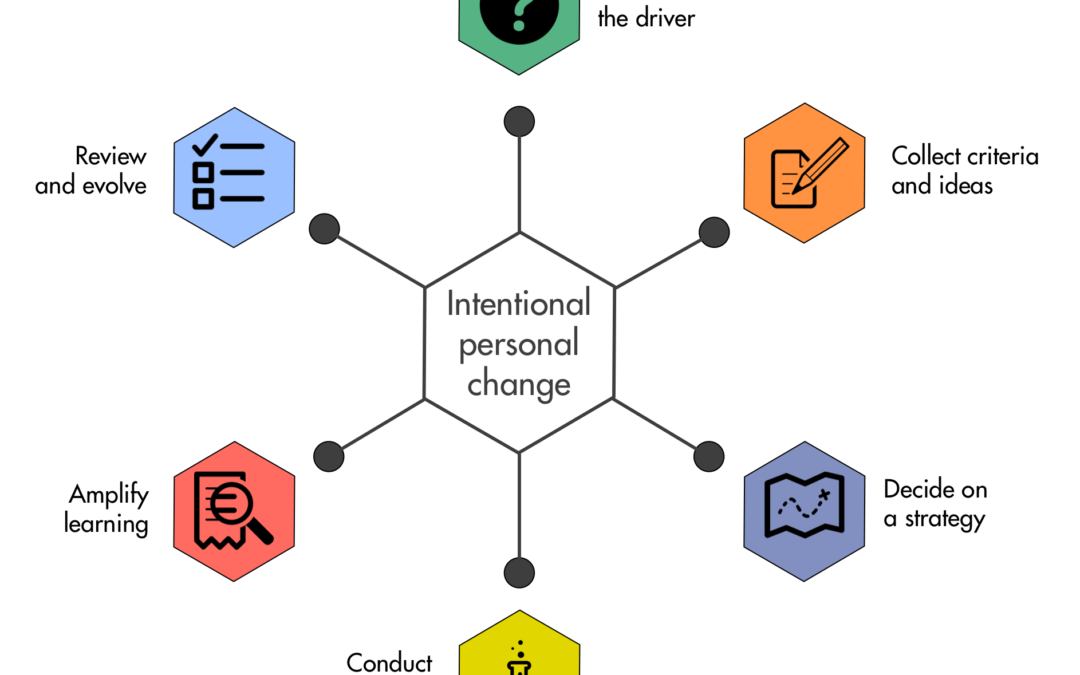
by Bernhard Bockelbrink | Jun 22, 2016 | Change, eBooks, Sociocracy 3.0
download pdf download ePub visit s3-for-one.com
Over the past months, I have been experimenting with applying Sociocracy 3.0 (a.k.a. ’S3′) as a framework for personal development and as a method for guiding and documenting one-on-one coaching sessions. The result is an eBook called “S3 for One”, with a dedicated website at http://s3-for-one.com.
Do you want to improve your communication skills, develop a healthier lifestyle, read more, love more, learn a new language, or get a new job? S3 for One provides you with a structured process to navigate intentional change in your life, be it just a small habit, a big change, a tricky decision or even the discovery of what you want to do with your life.
S3 for One is an adaptive process, it allows you to go as fast or as slow as you want (or can). It facilitates understanding about yourself and the situation you’re in, and helps you translate this learning into intentional and incremental change. The underlying idea is simple: you assess your situation and your needs (your driver), identify possible strategies and decide which one looks most promising, and then you create a series of small experiments to discover whether or not you can successfully implement your strategy. Each experiment will reveal new information about yourself, your situation, and your strategy, so you can easily adapt and evolve your approach. (more…)


















